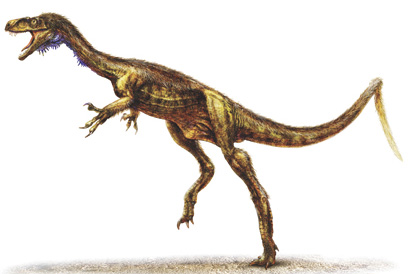 The dinosaur family tree just added a new relative: a small, nipping, meat-eating creature dating back to dinosaurs’ earliest days.
The dinosaur family tree just added a new relative: a small, nipping, meat-eating creature dating back to dinosaurs’ earliest days.
Unearthed in 230-million-year-old rocks in
The dinosaur family tree just added a
At roughly 4 feet high and 10 to 15 pounds in weight, the newfound primitive dinosaur Eodromaeus would have been an agile but not fearsome hunter.
new relative: a small, nipping, meat-eating creature dating back to dinosaurs’ earliest days.

Unearthed in 230-million-year-old rocks in
Eodromaeus joins its kin Eoraptor, a similar-sized dinosaur known to have lived in the same time and place. In fact, when researchers first unearthed Eodromaeus they thought the bones belonged to Eoraptor. Yet the two dinosaurs’ superficial resemblance belies a crucial difference: one ate plants while the other ate meat.
“From 20 feet away you’d do a double take — will the animal run from you or take your leg off?” says team member Paul Sereno, a paleontologist at the
The Science paper describes not only the newfound remains of Eodromaeus, but also a wealth of other Argentinean fossils that illuminate how the earliest dinosaurs evolved and what their environment was like. “The new dinosaur is special for sure, but we also have the first step of the radiation of the dinosaur story,” says Ricardo Martinez, the paper’s lead author and a paleontologist at the National University of San Juan in
Fossil evidence shows that the first dinosaurs appeared around 230 million years ago, as ecosystems were rejiggering themselves after a massive extinction that ended the Permian period, 250 million years ago. Many researchers have thought that as dinosaurs rose to prominence they muscled out other animal groups.
But
Distinguishing early dinos from each other isn’t easy, as their fossils lie so close to the initial evolutionary radiation. “When you find animals that evolved just after the split of major branches, they’re all going to look really similar,” says Randall Irmis, curator of paleontology at the Utah Museum of Natural History and an assistant professor in geology at the
Sereno discovered Eoraptor in 1991, and he later described it as a theropod, a group of dinosaurs that mainly ate meat. After doing more detailed studies, the team decided to reclassify Eoraptor in the new paper as an early sauropod, the other main group of dinosaurs, which mainly ate plants.
Unlike Eoraptor’s identification, Eodromaeus’ classification as a theropod is right from the start, researchers believe. It has sharp teeth for cutting meat, says
Eodromaeus joins not only Eoraptor but also a host of other early dinosaurs that roamed what is now
“What we have is this unbelievable graveyard of the earlier dinosaurs,” says Sereno. “We don’t have a lot of places like this.”
Unfortunately, this dinosaur trove ends with the Ischigualasto rocks. The older rocks beneath it, says

 Previous page
Previous page Back to top
Back to top







